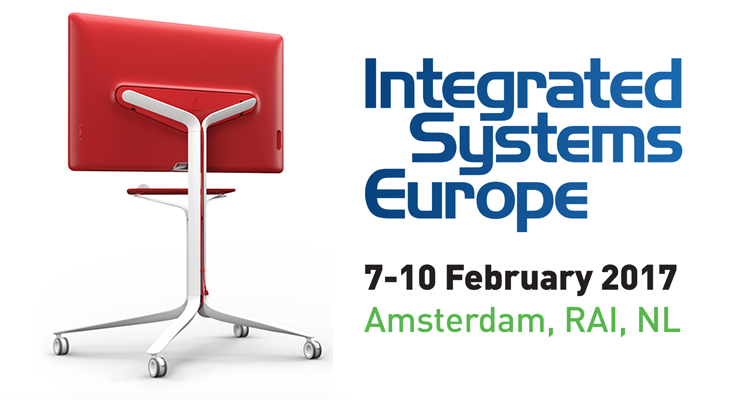The Crazy, Cautious and Amazing Future of Collaboration Boards — My Virtual Visit to ISE 2017

I am in Amsterdam.
Or, at least I believe I am at this point. As many of you know, I am in the middle of a very large project and was unable to travel to Amsterdam for ISE this year. This is a pilgrimage I’ve made every year for quite a long time, in fact as long as the show has been in its current form. I was really disappointed not to be able to make the trip, not only because I have many friends in Amsterdam after all these years, but because I consider it the most important show in the audiovisual industry. However, in my disappointment, I decided to try to put my money where my mouth is. I spend my days helping organizations make distance irrelevant through videoconferencing and collaboration. In fact, I had considered attending the show using one of the videoconferencing robots that we now sell, but the construction of the convention center in Amsterdam being in many buildings prevents its use. For those of you will have not been to the RAI, it is in over a dozen buildings scattered over many acres.
So I decided that this week I would go on Amsterdam time, living in my videoconferencing equipped studio at home, and find out just how close I could come to monitoring the show as if I was there.
First of all, I discovered that jet lag is not something that you get from traveling. I know this because I have it now. It comes from being totally out of sync with the actual clock. So, all of the things that I write about the show and all of the podcasts that I do will look and sound just like last year, and you will see that I am both fascinated by what is going on and a little foggy. Yesterday, I recorded my first podcast with Gary, and we both look equally bleary-eyed.
So, each day I will be doing the daily podcast with Gary that we have always done to sum up the show. In between times, I will be following all of the coverage that is submitted and talking to various manufacturers and reps both here and in Amsterdam about the products that are being released and the events that are happening.
The news from day one:
First came the most important news as far as the industry is concerned. That is that the show drew more people than last year, proving that the current atmosphere in the world is not restricting travel or industrial participation as much as many of us thought it might. Those of us in the audiovisual industry have always been adventurous anyway. I live in the very cautious world of banks and hedge funds, which make up the majority of my clients. And I will tell you that the current world atmosphere has restricted their travel considerably, and is producing a huge boom in videoconferencing and collaboration sales.
Speaking of collaboration sales, the biggest news of the show from day one seems to be the introduction of the Cisco Spark Board. For those of you in the fruit and vegetable industry (who would be the only people who have not heard about it yet), it’s a touchscreen LED monitor that works with Cisco’s Spark collaboration system, a software system that takes you all the way from instant messaging to videoconferencing and everything in between — a collaboration board. I have a number of customers trying Spark. I’ve tried it myself — I love it and the interface, but my own organization can’t adopt it due to the fact that we have automated email that ties with our project management system. This is the downside of the entire product: You must adopt the way the product works, and that adoption ends up affecting people that don’t even use the board. In other words, if an organization wants to begin using the Spark Board in its executive conference rooms and huddle rooms, everyone in the organization must adopt Spark as their email, videoconferencing, and messaging clients. Otherwise, the organization will not have complete availability of their important operations data through Spark. This is the problem with my own organization, a Cisco dealer — for many years we have been developing a system where our emails and messages are automatically filtered for project management details and placed into the appropriate threads in our project management system. I don’t know for sure yet that we can’t adopt Spark, but I am certain that it wouldn’t be easy.
Another piece of news missing from the show that I am able to comment on because I am here rather than there, is that the Spark Board has an enormous competitor simultaneously coming to market in the Google Jamboard. This product works the same way that the Spark Board does — you must adopt its system for collaboration in order to use the board. The difference with the Google Jamboard is that all of its sharing is done through Google software, as you might expect. To get full functionality, you need to be using Google Docs, and Google’s system for email and sharing. The other big difference is that the Google Jamboard is considerably less expensive than the Cisco board. So this is going to produce an enormous competition in the market. Both of them are companies dominant in their fields, and you know that Cisco’s advertising budget for the Spark Board is huge. However, not only is Google’s budget even bigger, they also own the largest advertising channel. As a result, at the office, while both of these collaboration boards have been advertised for about the same period of time, we get FAR more inquiries already about the Google Jamboard. Of course, we have already had many kinds of collaboration boards in the market from companies like Sharp and InFocus, but these two boards, because of their integrated software, are considerably easier to use than their predecessors.
Some of you are probably saying, “What about the Microsoft product that was going to completely dominate the market?” Well, if you would look back at my podcast from last year, and from the year before, I predicted that Microsoft would never be the ones to dominate this market. I have had several important clients adopt the Microsoft board temporarily. But it is expensive and confusing. Both the new Cisco Spark Board and the new Google Jamboard are going to do better in the collaboration board market (I predict).
Other news from the show is that VR has a smaller presence than I thought it would have. This is probably because the big push in VR product is coming from outside our industry. Current proponents like Google and Facebook do not exhibit their products at the show, which is something that must change. These products are going to have an enormous influence in the industry, and while we don’t know the final form that they will take, we do know that the advertising budgets that are making our clients aware of these products are equally massive.
Have to end this now. The show is opening in Amsterdam and I need to virtually travel to the show, which is downstairs in my studio. Follow us for more coverage.





